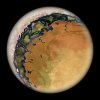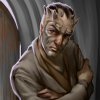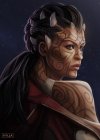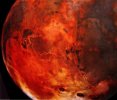Verena
Devil woman
Named by humans: Gehenna (Meaning “Hell”, named by the first human explorers that were unable to cope with the living conditions)
Original name: Aorastra
Capital: Vlofstin
The planet Gehenna is tidally locked to its star, a red dwarf, Kimsra. What this means is that the planet’s orbital period is the same as its rotational so that the same side is always facing the star. As it is with most red dwarfs, the star releases flares every once in a while, during which it undergoes unpredictable dramatic increases in brightness for a few minutes.
Temperatures of the star-ward side exceed 100 degrees C, while on the dark side they fall below -100 C. The majority of the water on the star-ward side evaporates and is carried by the wind to the dark side where it condenses into ice. Water that is left on the hot side is in a vapour form.
There is a circulation of atmosphere thanks to the air on the star-ward side being constantly heated, expanding and creating a vacuum that sucks in the expanding hot air from the other side, which leads to distributing the heat across the planet, equalizing the temperatures.
In this state, a circular belt between the two sides, a sort of twilight zone, is the only place where life can evolve and flourish. In this dusk band around the planet, the star is permanently hanging very low near the horizon with an ever-colourful red, yellow sky due to scattered light, resembling a never-ending sunset. Time as we know it is, in this sense, nonexistent for the planet’s inhabitants. Time is measured not in hours but the time between solar flares.
There is a constant flow of water from the night side to the dayside – a series of rivers and streams, all flowing in the same direction. The erosion these rivers cause creates enormous caves and canyons, used by the inhabitants to construct small and large settlements. A great deal of the water that evaporates on the star-ward side comes down in the form of rain in the twilight zone, further contributing to plant growth, before reaching the cold side where it freezes.
Gehenna is a typical eyeball planet:

Flora and fauna: Flora and fauna vary according to region. Plantlife has adapted to the constant winds that blow unpredictably from both directions of the planet, as well as the solar flares, for example by anchoring securely into the soil, similar to weeds and sprouting flexible branches that can withstand even the strongest of winds. During solar flares, many plants retract into huge underground bulbs.
The prevailing vegetation consists of different types of grasses, bushes, shrubs and small trees. Underwater, vast blooms of photosynthetic plankton and bioluminescent algae support the life of fish, amphibians and invertebrates. Underground, bioluminescent fungi spread quickly, increasing their brightness upon touch.
The tail of the amphibian krus mimics its head to fool predators

Lush forests of Amdrakk trees similar to mangroves dot the underground systems. Their false trunks are made up of many intertwined roots that spread quickly and deeply. Oftentimes, entire forests consist of a single organism. Once a year, each root sprouts branches bearing multiple sweet and nourishing fruits similar to an Annona. Once ripe, they fall to the ground and shoot roots.
A stream passes through an Amdrakk forest, nourishing the fruiting trees:


Bosrakk are bat-like creatures with eight limbs that keep the fruit of the Amdrakk trees free from pests:

The trees are also home to the kreksi, creatures as big as hawks that closely resemble dragons from legends:

Both animals and Gehennians mostly occupy the huge and complex underground cave systems, as well as natural tunnels carved into the canyons. In between flares, many also leave the caves to graze or hunt on the surface. There are both tiny and enormous animals – some are as small as fleas, while others, such as the ramkski, are as big as African elephants. All of them are covered either in scales or thick skin but no fur. There are no mammals. Only hours from hatching or birth, animals are able to run and fend for themselves.
Ramski are among the largest animals on the planet:

Daideroni are the apex predators of Gehenna. They are both elegant and powerful, as large as horses, travel and hunt in packs. Daideroni have the personality of wolves and extraordinary intelligence, able to understand keywords and whole phrases in Gehennian. Few individuals are able to tame, ride and hunt with them, after which they gain an ally for life. Many believe that daideroni are actually the ancient ancestors of Gehennians and it’s easy to see why.
Daideroni are not to be trifled with:


Abilities: All creatures of Gehenna possess a heightened sense of sight, smell and hearing. Their eyes are protected from dust and debris underground by a nictitating membrane. They are able to see as well in low light conditions as humans during the daytime. However, their vision is much more sensitive to UV light. During a typical sunny day on Earth, creatures of Gehenna see as well as us during the night. Therefore, a huge weakness of these heightened senses is all sorts of extremes – bright light, noises and smells.
Gehennians/Aorastri
Gehennians have slit pupils similar to those of vipers with irises ranging in colour. Their entire bodies are covered in mostly dark-coloured, extremely sharp scales of various shapes and sizes. These protect them from the harsh climate on their home planet but also act as natural armour, to an extend. Fully developed individuals shed their entire skin once a year, children and teens that are still growing do so more often. Gehennians are unable to wear most types of normal attire and armour due to their sharp and protruding scales. They instead opt for loose clothing and scarves made of durable materials such as leather, fine chainmail or linen.
They possess long prehensile tails used both for balance and grasping objects. Gehennians are bipedal and walk on digitigrade legs. Their padded hands and feet both have five fingers/toes each and end in long, curved claws that enable them to easily slice through flesh and climb even the steepest of rocks.
Their animalistic legs, combined with a tail, allow them to run faster, jump higher and fall further than humans. However, they sacrifice endurance. A human can outrun a Gehennian on a long-distance jog.
Both males and females possess a pair of uniquely shaped horns that are sometimes a different colour than the rest of the body. They can be used to carry burdens but also during combat. Gehennians often decorate and paint their horns to represent a variety of meanings. They grow as the Gehennian matures and ages.
Gehennians are polyphyodonts, meaning that their teeth are continually replaced. They are carnivores but are also able to digest some plant matter. A typical, well-nourished individual can last for nearly 3 months without food. Due to the different nutritional value of foods outside of Gehenna, they need to change their diet in order for their bodies to function properly. For example, because meat from animals in their homeworld is higher in calcium, Gehennians need to eat more calcium-rich foods outside of it to prevent their scales from becoming brittle.
Gehennians mate for life and give birth to a single small but nearly fully developed young. They have an average lifespan of 70-100 years. Children are given an initial name by their parents but may choose to change it later in life. Families don’t use traditional surnames, although warriors, craftsmen or scholars may use their profession as a surname. The dead are left on the surface of the planet to be consumed by the flames of a solar flare, returning them to the earth.
Despite modern technology, many Gehennians still prefer using primitive weapons such as bow and arrow and spears

Way of life: Aside from a few large multicultural settlements, mostly their capital Vlofstin, Gehennians prefer smaller, tight-knit communities. They build their housing by carving rooms and furniture directly out of the stone using tools and also their claws. Decorations are handcrafted from natural materials such as clay, bones, wood, shells etc. Bioluminescent moss and fungi are planted on the walls and used for lighting. Gehennians sleep on smoothly carved stone beds, rolling up into a sharp ball of spikes. Many keep various smaller animal species as pets, some more successfully than others.
The soil on Gehenna is rich in precious metals and stone. The people are exceptional craftsmen and architects but aren’t technologically advanced due to the lack of electricity. They love to read and write and have a great memory. Music played on instruments similar to lithophones, aeolian harps and handpan drums is a big part of their culture. Gehennians don’t form tribes, don’t have a military and don’t wage wars with each other. They have no currency and instead use barter to trade.
Gehennians follow a religion that by human standards can be identified as a combination of Shamanism and Animism. Children and animals born with albinism are believed to be linked spiritually to their main deity, their star, and be able to predict solar flares among other natural disasters. They are also believed to possess a variety of magical powers, ranging from healing powers to communicating by telepathy through dreams. These rare individuals are treated with great honour and viewed as leaders.
Although all races are welcome on Gehenna, few are able to adapt to the extreme living conditions. Due to their similarity to various reptiles on Earth, their lack of technology and science, Gehennians are oftentimes viewed as beastly and uncivilized. Enslavement, exploitation and illegal mining operations are huge issues that remain unsolved. However, rebellions are brewing that might change the course of history.
Entrance to one of many underground caves:

Houses in the Saiin cave are carved entirely out of huge plant bulbs:

The ancient temple of the sun, intricately carved out of stone:

Original name: Aorastra
Capital: Vlofstin
The planet Gehenna is tidally locked to its star, a red dwarf, Kimsra. What this means is that the planet’s orbital period is the same as its rotational so that the same side is always facing the star. As it is with most red dwarfs, the star releases flares every once in a while, during which it undergoes unpredictable dramatic increases in brightness for a few minutes.
Temperatures of the star-ward side exceed 100 degrees C, while on the dark side they fall below -100 C. The majority of the water on the star-ward side evaporates and is carried by the wind to the dark side where it condenses into ice. Water that is left on the hot side is in a vapour form.
There is a circulation of atmosphere thanks to the air on the star-ward side being constantly heated, expanding and creating a vacuum that sucks in the expanding hot air from the other side, which leads to distributing the heat across the planet, equalizing the temperatures.
In this state, a circular belt between the two sides, a sort of twilight zone, is the only place where life can evolve and flourish. In this dusk band around the planet, the star is permanently hanging very low near the horizon with an ever-colourful red, yellow sky due to scattered light, resembling a never-ending sunset. Time as we know it is, in this sense, nonexistent for the planet’s inhabitants. Time is measured not in hours but the time between solar flares.
There is a constant flow of water from the night side to the dayside – a series of rivers and streams, all flowing in the same direction. The erosion these rivers cause creates enormous caves and canyons, used by the inhabitants to construct small and large settlements. A great deal of the water that evaporates on the star-ward side comes down in the form of rain in the twilight zone, further contributing to plant growth, before reaching the cold side where it freezes.
Gehenna is a typical eyeball planet:

Flora and fauna: Flora and fauna vary according to region. Plantlife has adapted to the constant winds that blow unpredictably from both directions of the planet, as well as the solar flares, for example by anchoring securely into the soil, similar to weeds and sprouting flexible branches that can withstand even the strongest of winds. During solar flares, many plants retract into huge underground bulbs.
The prevailing vegetation consists of different types of grasses, bushes, shrubs and small trees. Underwater, vast blooms of photosynthetic plankton and bioluminescent algae support the life of fish, amphibians and invertebrates. Underground, bioluminescent fungi spread quickly, increasing their brightness upon touch.
The tail of the amphibian krus mimics its head to fool predators

Lush forests of Amdrakk trees similar to mangroves dot the underground systems. Their false trunks are made up of many intertwined roots that spread quickly and deeply. Oftentimes, entire forests consist of a single organism. Once a year, each root sprouts branches bearing multiple sweet and nourishing fruits similar to an Annona. Once ripe, they fall to the ground and shoot roots.
A stream passes through an Amdrakk forest, nourishing the fruiting trees:


Bosrakk are bat-like creatures with eight limbs that keep the fruit of the Amdrakk trees free from pests:

The trees are also home to the kreksi, creatures as big as hawks that closely resemble dragons from legends:

Both animals and Gehennians mostly occupy the huge and complex underground cave systems, as well as natural tunnels carved into the canyons. In between flares, many also leave the caves to graze or hunt on the surface. There are both tiny and enormous animals – some are as small as fleas, while others, such as the ramkski, are as big as African elephants. All of them are covered either in scales or thick skin but no fur. There are no mammals. Only hours from hatching or birth, animals are able to run and fend for themselves.
Ramski are among the largest animals on the planet:

Daideroni are the apex predators of Gehenna. They are both elegant and powerful, as large as horses, travel and hunt in packs. Daideroni have the personality of wolves and extraordinary intelligence, able to understand keywords and whole phrases in Gehennian. Few individuals are able to tame, ride and hunt with them, after which they gain an ally for life. Many believe that daideroni are actually the ancient ancestors of Gehennians and it’s easy to see why.
Daideroni are not to be trifled with:


Abilities: All creatures of Gehenna possess a heightened sense of sight, smell and hearing. Their eyes are protected from dust and debris underground by a nictitating membrane. They are able to see as well in low light conditions as humans during the daytime. However, their vision is much more sensitive to UV light. During a typical sunny day on Earth, creatures of Gehenna see as well as us during the night. Therefore, a huge weakness of these heightened senses is all sorts of extremes – bright light, noises and smells.
Gehennians/Aorastri
Gehennians have slit pupils similar to those of vipers with irises ranging in colour. Their entire bodies are covered in mostly dark-coloured, extremely sharp scales of various shapes and sizes. These protect them from the harsh climate on their home planet but also act as natural armour, to an extend. Fully developed individuals shed their entire skin once a year, children and teens that are still growing do so more often. Gehennians are unable to wear most types of normal attire and armour due to their sharp and protruding scales. They instead opt for loose clothing and scarves made of durable materials such as leather, fine chainmail or linen.
They possess long prehensile tails used both for balance and grasping objects. Gehennians are bipedal and walk on digitigrade legs. Their padded hands and feet both have five fingers/toes each and end in long, curved claws that enable them to easily slice through flesh and climb even the steepest of rocks.
Their animalistic legs, combined with a tail, allow them to run faster, jump higher and fall further than humans. However, they sacrifice endurance. A human can outrun a Gehennian on a long-distance jog.
Both males and females possess a pair of uniquely shaped horns that are sometimes a different colour than the rest of the body. They can be used to carry burdens but also during combat. Gehennians often decorate and paint their horns to represent a variety of meanings. They grow as the Gehennian matures and ages.
Gehennians are polyphyodonts, meaning that their teeth are continually replaced. They are carnivores but are also able to digest some plant matter. A typical, well-nourished individual can last for nearly 3 months without food. Due to the different nutritional value of foods outside of Gehenna, they need to change their diet in order for their bodies to function properly. For example, because meat from animals in their homeworld is higher in calcium, Gehennians need to eat more calcium-rich foods outside of it to prevent their scales from becoming brittle.
Gehennians mate for life and give birth to a single small but nearly fully developed young. They have an average lifespan of 70-100 years. Children are given an initial name by their parents but may choose to change it later in life. Families don’t use traditional surnames, although warriors, craftsmen or scholars may use their profession as a surname. The dead are left on the surface of the planet to be consumed by the flames of a solar flare, returning them to the earth.
Despite modern technology, many Gehennians still prefer using primitive weapons such as bow and arrow and spears

Way of life: Aside from a few large multicultural settlements, mostly their capital Vlofstin, Gehennians prefer smaller, tight-knit communities. They build their housing by carving rooms and furniture directly out of the stone using tools and also their claws. Decorations are handcrafted from natural materials such as clay, bones, wood, shells etc. Bioluminescent moss and fungi are planted on the walls and used for lighting. Gehennians sleep on smoothly carved stone beds, rolling up into a sharp ball of spikes. Many keep various smaller animal species as pets, some more successfully than others.
The soil on Gehenna is rich in precious metals and stone. The people are exceptional craftsmen and architects but aren’t technologically advanced due to the lack of electricity. They love to read and write and have a great memory. Music played on instruments similar to lithophones, aeolian harps and handpan drums is a big part of their culture. Gehennians don’t form tribes, don’t have a military and don’t wage wars with each other. They have no currency and instead use barter to trade.
Gehennians follow a religion that by human standards can be identified as a combination of Shamanism and Animism. Children and animals born with albinism are believed to be linked spiritually to their main deity, their star, and be able to predict solar flares among other natural disasters. They are also believed to possess a variety of magical powers, ranging from healing powers to communicating by telepathy through dreams. These rare individuals are treated with great honour and viewed as leaders.
Although all races are welcome on Gehenna, few are able to adapt to the extreme living conditions. Due to their similarity to various reptiles on Earth, their lack of technology and science, Gehennians are oftentimes viewed as beastly and uncivilized. Enslavement, exploitation and illegal mining operations are huge issues that remain unsolved. However, rebellions are brewing that might change the course of history.
Entrance to one of many underground caves:

Houses in the Saiin cave are carved entirely out of huge plant bulbs:

The ancient temple of the sun, intricately carved out of stone:

Last edited:







